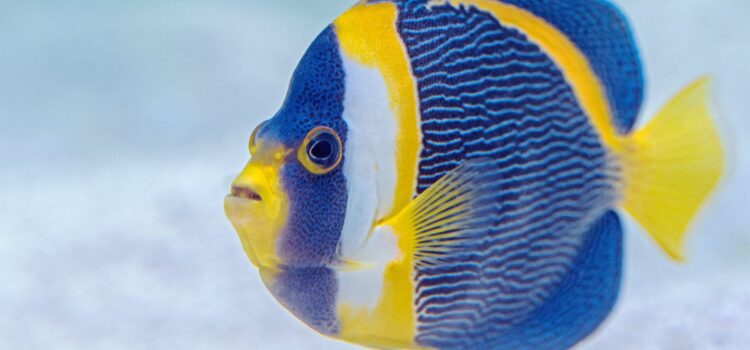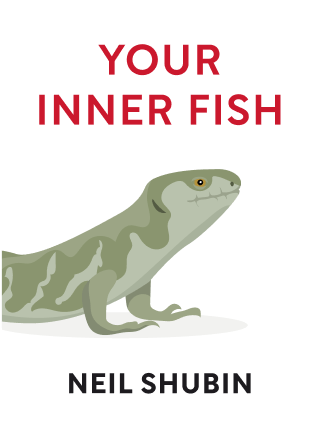

This article is an excerpt from the Shortform book guide to "Your Inner Fish" by Neil Shubin. Shortform has the world's best summaries and analyses of books you should be reading.
Like this article? Sign up for a free trial here .
How did human evolution from fish occur? Did humans really evolve from fish, and how do we know?
Human evolution from fish occurred over billions of years of life on Earth. There is scientific evidence of human evolution from fish.
Read more about human evolution from fish and why it matters.
Human Evolution From Fish
Many features of the human body are just complex versions of those in simpler creatures that, at first glance, seem totally unlike us. But there is some evidence for human evolution from fish.
In Your Inner Fish, Neil Shubin, a professor and paleontologist who studies fish fossils, explains that understanding how a shark’s head, a reptile’s brain, and a fish’s fins developed helps make sense of complicated and confounding human anatomy, and also outlines how humans evolved from fish.
Shubin’s story starts in the Canadian Arctic, where he and colleagues discovered a key link in the chain from the earliest creatures to humans: a 375-million-year-old fossil fish, Tiktaalik, that developed features for living on land. Tiktaalik’s rudimentary joints, including a head free of the shoulder, are precursors to those of amphibians, reptiles, birds, mammals—and humans. This helps explain human evolution from fish.
Casting new light on the human family tree, ancient fossils like Tiktaalik, as well as embryos and DNA, provide clues to a story of human development stretching back 3.5 billion years and includes the human evolution from fish.
Fossil Clues to Human Development and Human Evolution From Fish
Fossils are one of three major types of evidence for how human bodies developed and how they work; the others are embryos and genes.
To understand the origins of land animals and their connection to humans, Shubin set out to find evidence of the first limbed animal, or fish that walked on land. This provides evidence that humans evolved from fish. r
In 2004, after four expeditions over six years in the Canadian Arctic, he and his team found a fossil skeleton of a transitional creature between fish and land animals. Like a fish, it had scales and fins with fin webbing, but like a land animal, it had a flat head with eyes on top and a neck. Also, the fins contained bones corresponding to salamander-type shoulder, elbow, and wrist joints, giving it the ability to propel itself on land.
The land-fish, called Tiktaalik, is as important to human history as the African hominid fossil Lucy. Through Lucy, we trace our primate history; Tiktaalik tells us our history as fish. The story of the development of human anatomy through small changes over millennia can be read in fossils, as well as in our genes through DNA—starting with our “inner fish.”
A Skeletal Pattern for Limbs
This book shows how scientists can trace bones, teeth, the DNA recipe, and the biological process for building organs from early creatures to humans. These similarities show that the world’s diverse creatures are variations on a theme.
Fish like Tiktaalik carried the pattern or blueprint for our hands and feet, which would continue to develop and be refined over hundreds of millions of years through a progression of fish, amphibians, and reptiles.
For example, in the 1800s, scientists found that nearly all animals with limbs (wings, flippers, bones, or hands) have the same structural limb design, although the shape and size of the bones vary. In this shared limb design, one bone connects with two, which attach to an array of small knucklebone-type “blobs,” which connect to digits.
Tiktaalik’s fin was a primitive version of a limb—a wrist bone with spaces for four other bones. Its hand-like fins likely enabled Tiktaalik to move along the bottom of streams or ponds and flop its way across mudflats.
A DNA Recipe for Limbs
Just as echoes of our bone development can be seen in earlier animals, our genetic recipe also traces back to other creatures. This shows that humans evolved from fish, and the journey of human evolution from fish.
All cells contain the same DNA. But organ and tissue cells develop differently because certain genes (stretches of DNA) in the cells are active while others are turned off.
In an embryo of any animal, the genetic switches for making limbs activate between the third and eighth weeks, and limbs start developing. First, tiny buds protrude from the embryonic body, then the tips develop into paddles. A patch of tissue in the paddles’ tips, called the ZPA, controls development of the bone pattern of limbs by varying the concentration of a molecule in the cells building the limb.
In the 1990s, researchers identified the mystery molecule dictating limb development, which they called the Sonic hedgehog gene (named for a video game character). Experiments manipulating the gene to produce limbs in chicken, mouse, shark, and skate embryos showed that all appendages, whether fins or limbs, share the same DNA recipe.
A Pattern in Our Heads
The complicated assemblage of bones, tissue, muscles, arteries, and nerves that comprises our head is based on a simple plan found in sharks, with echoes of even earlier structures in headless worms. This also helps answer the question: did humans evolve from fish?
The human head begins forming at the base of the embryo at about three weeks. Four swellings called arches develop in the area that will be the throat. Specific cells in each arch form bone, muscle, and blood vessels.
Cells from the first arch form the upper and lower jaws and two of the ear bones. Cells from the second arch form the third ear bone, a throat bone, and facial muscles. Third-arch cells form bones, muscles, and nerves in the throat that are used to swallow. Finally, cells from the fourth arch form the deep part of the throat, including the larynx and its surrounding muscles and vessels.
Our head reflects the same pattern as those of sharks, fish, and salamanders. The arches of the human embryo look much like the gill slits in the throat area of sharks and fish, although human gill slits are sealed by the plates of the skull before birth. The arches in sharks and humans develop comparable body systems.
These patterns stretch back even further than sharks—to worms that don’t really have heads. A worm called amphioxus lacks a skull but has a notochord—a nerve cord and jelly-filled rod like a primitive version of a backbone. Human embryos also have a notochord, which breaks up to become jelly-filled disks between our vertebrae.
A Body Design
Just as we share common designs for our hands, limbs, and heads with other creatures, we share our basic body design with other creatures as well. It starts with embryos, which go through the same early stages of development, regardless of the animal type.
Animals as diverse as humans, fish, lizards, birds, amphibians, and mammals all have symmetrical bodies of the same design—with a front/back, top/bottom, and left/right, plus a head, spinal cord, and organs in specific places. Heads and feet point forward in the direction we move and the butt points the opposite direction.
When you look at embryos, there are many more similarities among animals than differences.
Every animal’s organs start in one of three layers of tissue called germ layers. For example, every type of animal’s heart forms from the same layer. The layers are:
- Ectoderm: an outer layer, which becomes hair, skin, nervous system
- Endoderm: an inner layer, which becomes the guts or inner structures of the digestive system and glands
- Mesoderm: a middle layer, which becomes the body cavity plus tissue, skeleton, and muscles
All animals with a backbone have gill arches and notochords and look the same in the early embryo stages. Distinctive features such as a bigger brain in humans, shells on turtles, and feathers on birds, develop later.
Body Building Blocks
In simplest terms, a body is a group of cells that perform different individual functions (have a division of labor) but together create a greater whole. To form bodies, cells have to be able to: 1) attach to each other to create specific materials like bone, and 2) communicate with each other.
1) Sticking Together: Some of the earliest bodies were multi-celled creatures that lived in the seas 600 million years ago. They were made of the same type of “glue” (collagen and proteoglycan) that allows human body cells to stick together to build materials and organs. In our bodies, this glue is a mix of molecules that differs depending on the organ it’s forming—for instance, a bone versus an eye. Without the molecule mix attaching cells to each other, bodies couldn’t be formed.
In addition to the molecule mix, cells stick together by using various types of molecular rivets. Some work like contact cement gluing the outsides of two cells together. Other rivets bond only to cells with the same kind of rivet, a mechanism that enables cells to organize and ensures that bone cells stick to bone cells, skin cells stick to skin cells, and so on. This helps provide insight on the question “did humans evolve from fish?”
2) Communicating: To build bodies, cells must communicate so they know when to divide, make molecules, and die.
They communicate by sending out molecules with messages. A cell sends a signal or molecule, which attaches to the outside of a receiving cell. This sets off a chain reaction of molecules within the cell as the message travels from the outer membrane to the nucleus. As a result, the cell receiving the information changes its behavior.
One of the simplest bodies is a placozoan, a live blob first found on aquarium glass in the 1800s. It has a plate-shaped body with only four types of cells, yet they have a division of labor and rivet connections, and they communicate.
So did humans evolve from fish? The evidence suggests yes.

———End of Preview———
Like what you just read? Read the rest of the world's best book summary and analysis of Neil Shubin's "Your Inner Fish" at Shortform .
Here's what you'll find in our full Your Inner Fish summary :
- How your hands and feet are like a fish that lived hundreds of millions of years ago
- How the structure of your head can be traced back to an ancient, headless worms
- What parts of your body are uniquely human






Explain this to me. A fish dies within seconds of being out of the water. A fish has no lungs. How does something evolve from one environment that gives them life (water) to another environment (air) that instantly kills it? Did a fish flop up on the sand and just before it died its body developed ONE cell that would eventually create a body with lungs? And that one cell mutated over a billion years in millions of other fish until they grew a full set of lungs? But wait, that fish that developed that one cell died. So how did it pass on any DNA to other fish that eventually evolved into lungs? If the human race all dove into the sea and tried to breath underwater, and we did this for a billion years, would be become fish? Or, would we all simply die? A bigger question, why would a human try to live underwater? Why would we keep diving in the water? Why did that fish keep flopping out onto the sand? Can you explain?
This is an easy question to answer, its because of natural selection. Something caused the fish to need to leave the water (nobody knows what it is) over time the fish who have genetic makeup that allow them to do that pass their genes on from natural selection, this process take months to hundreds of millions of years depending on the creature. I don’t understand why you are confused basically everyone above the age of 14 has learned about this to some degree. But you can believe what you want. I genuinely don’t care.
We see the walking catfish as a perfect example of a fish being able to live out of water for a period of time before returning to the water. Just like the catfish the others that tested out of water breathing devoloped what was needed to survive on land. If you don’t try, if you don’t dream, if you don’t hope for something you stay where you are and never do change.